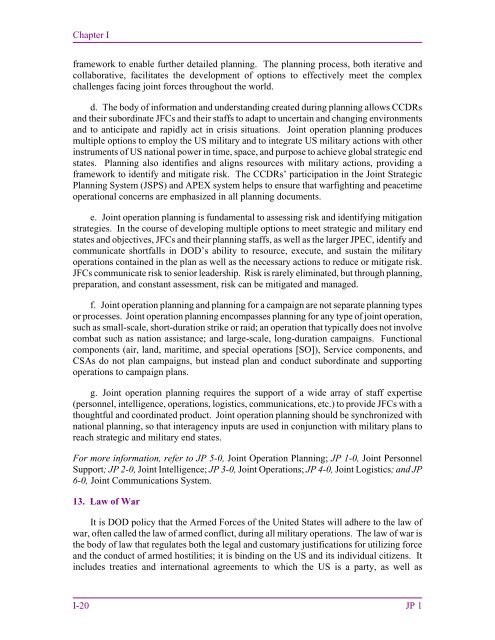JP 1, Doctrine for the Armed Forces of the United States - Defense ...
JP 1, Doctrine for the Armed Forces of the United States - Defense ...
JP 1, Doctrine for the Armed Forces of the United States - Defense ...
Create successful ePaper yourself
Turn your PDF publications into a flip-book with our unique Google optimized e-Paper software.
Chapter I<br />
framework to enable fur<strong>the</strong>r detailed planning. The planning process, both iterative and<br />
collaborative, facilitates <strong>the</strong> development <strong>of</strong> options to effectively meet <strong>the</strong> complex<br />
challenges facing joint <strong>for</strong>ces throughout <strong>the</strong> world.<br />
d. The body <strong>of</strong> in<strong>for</strong>mation and understanding created during planning allows CCDRs<br />
and <strong>the</strong>ir subordinate JFCs and <strong>the</strong>ir staffs to adapt to uncertain and changing environments<br />
and to anticipate and rapidly act in crisis situations. Joint operation planning produces<br />
multiple options to employ <strong>the</strong> US military and to integrate US military actions with o<strong>the</strong>r<br />
instruments <strong>of</strong> US national power in time, space, and purpose to achieve global strategic end<br />
states. Planning also identifies and aligns resources with military actions, providing a<br />
framework to identify and mitigate risk. The CCDRs’ participation in <strong>the</strong> Joint Strategic<br />
Planning System (JSPS) and APEX system helps to ensure that warfighting and peacetime<br />
operational concerns are emphasized in all planning documents.<br />
e. Joint operation planning is fundamental to assessing risk and identifying mitigation<br />
strategies. In <strong>the</strong> course <strong>of</strong> developing multiple options to meet strategic and military end<br />
states and objectives, JFCs and <strong>the</strong>ir planning staffs, as well as <strong>the</strong> larger <strong>JP</strong>EC, identify and<br />
communicate shortfalls in DOD’s ability to resource, execute, and sustain <strong>the</strong> military<br />
operations contained in <strong>the</strong> plan as well as <strong>the</strong> necessary actions to reduce or mitigate risk.<br />
JFCs communicate risk to senior leadership. Risk is rarely eliminated, but through planning,<br />
preparation, and constant assessment, risk can be mitigated and managed.<br />
f. Joint operation planning and planning <strong>for</strong> a campaign are not separate planning types<br />
or processes. Joint operation planning encompasses planning <strong>for</strong> any type <strong>of</strong> joint operation,<br />
such as small-scale, short-duration strike or raid; an operation that typically does not involve<br />
combat such as nation assistance; and large-scale, long-duration campaigns. Functional<br />
components (air, land, maritime, and special operations [SO]), Service components, and<br />
CSAs do not plan campaigns, but instead plan and conduct subordinate and supporting<br />
operations to campaign plans.<br />
g. Joint operation planning requires <strong>the</strong> support <strong>of</strong> a wide array <strong>of</strong> staff expertise<br />
(personnel, intelligence, operations, logistics, communications, etc.) to provide JFCs with a<br />
thoughtful and coordinated product. Joint operation planning should be synchronized with<br />
national planning, so that interagency inputs are used in conjunction with military plans to<br />
reach strategic and military end states.<br />
For more in<strong>for</strong>mation, refer to <strong>JP</strong> 5-0, Joint Operation Planning; <strong>JP</strong> 1-0, Joint Personnel<br />
Support; <strong>JP</strong> 2-0, Joint Intelligence; <strong>JP</strong> 3-0, Joint Operations; <strong>JP</strong> 4-0, Joint Logistics; and <strong>JP</strong><br />
6-0, Joint Communications System.<br />
13. Law <strong>of</strong> War<br />
It is DOD policy that <strong>the</strong> <strong>Armed</strong> <strong>Forces</strong> <strong>of</strong> <strong>the</strong> <strong>United</strong> <strong>States</strong> will adhere to <strong>the</strong> law <strong>of</strong><br />
war, <strong>of</strong>ten called <strong>the</strong> law <strong>of</strong> armed conflict, during all military operations. The law <strong>of</strong> war is<br />
<strong>the</strong> body <strong>of</strong> law that regulates both <strong>the</strong> legal and customary justifications <strong>for</strong> utilizing <strong>for</strong>ce<br />
and <strong>the</strong> conduct <strong>of</strong> armed hostilities; it is binding on <strong>the</strong> US and its individual citizens. It<br />
includes treaties and international agreements to which <strong>the</strong> US is a party, as well as<br />
I-20 <strong>JP</strong> 1

















